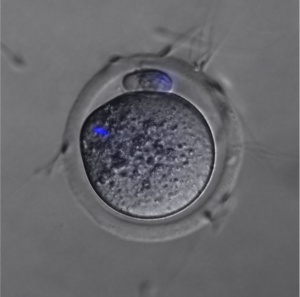Fertilization: Difference between revisions
No edit summary |
No edit summary |
||
| Line 4: | Line 4: | ||
[[File:Mouse-fertilization 01.jpg|thumb|The first polar body deforms the mammalian egg away from its encapsulating zona pellucida]] | [[File:Mouse-fertilization 01.jpg|thumb|The first polar body deforms the mammalian egg away from its encapsulating zona pellucida]] | ||
{{Template:Fertilization Links}} | {{Template:Fertilization Links}} | [http://embryology.med.unsw.edu.au/Notes/week1_5.htm original page] | ||
== Recent Findings == | == Recent Findings == | ||
Revision as of 22:31, 21 April 2010
Introduction
Fertilization is the fusion of haploid gametes, egg and sperm, to form the diploid zygote. Note though there can be subtle differences in the fertilization process which occurs naturally within the body or through reproductive technologies outside the body, the overall product in both cases is a diplod zygote. In fertilization research, after humans the mouse is the most studied species followed by domestic and farm animals. The process of fertilization involves components of, and signaling between, both sperm and egg.
Recent Findings
Objectives
- Understand the abnormalities that occur during this period of development.
- Understand the mechanisms of gamete formation.
- Understand the mechanisms of cell division.
- Describe the differences between mitosis and meiosis.
- Understand the mechanisms of fertilization, both in vivo and in vitro.
- Describe the cleavage of the zygote.
- Describe the processes in formation of the blastocyst.
- Have a preliminary understanding of the role and process in male sex determination and X inactivation.
References
Textbooks
- Human Embryology (2nd ed.) Larson Ch1 p1-32
- The Developing Human: Clinically Oriented Embryology (6th ed.) Moore and Persaud
- Before we Are Born (5th ed.) Moore and Persaud Ch 2 p14-33
- Essentials of Human Embryology Larson Ch1 p1-16
- Human Embryology Fitzgerald and Fitzgerald Ch2 p8-14
Search
- NCBI Bookshelf fertilization | fertilisation
- Pubmed fertilization | fertilisation
Related Movies
| Fertilization | Fertilization in Mouse | Pronuclear Fusion |
Original Embryology Links
K12 Embryology for K12 Students - Week 1
External Links
References
Reviews
Articles
Search Pubmed
Search Pubmed Now: fertilization | zygote
Glossary Links
- Glossary: A | B | C | D | E | F | G | H | I | J | K | L | M | N | O | P | Q | R | S | T | U | V | W | X | Y | Z | Numbers | Symbols | Term Link
Cite this page: Hill, M.A. (2024, May 18) Embryology Fertilization. Retrieved from https://embryology.med.unsw.edu.au/embryology/index.php/Fertilization
- © Dr Mark Hill 2024, UNSW Embryology ISBN: 978 0 7334 2609 4 - UNSW CRICOS Provider Code No. 00098G

